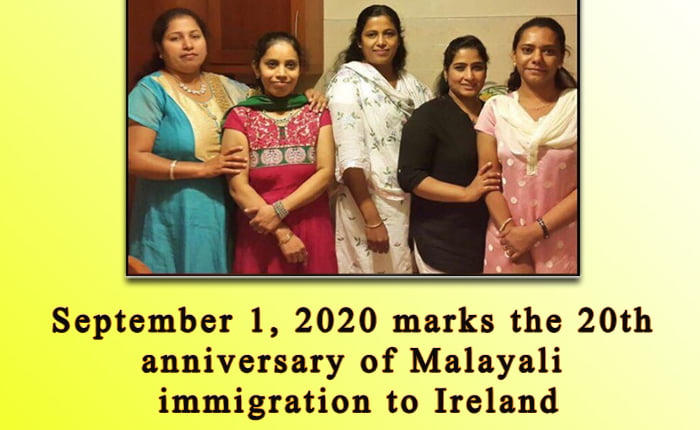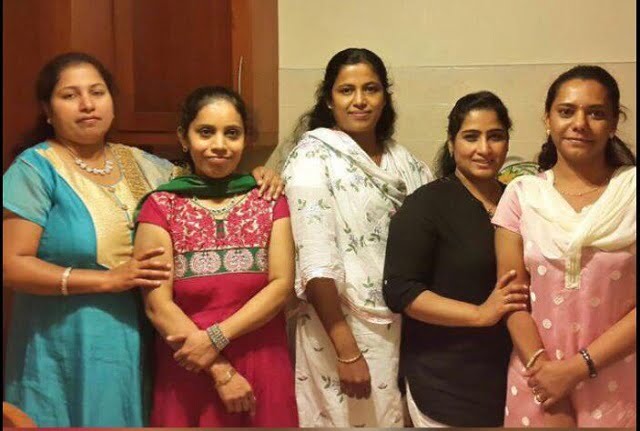Next month marks the 20th anniversary of Malayali immigration to Ireland. Undoubtedly a special occasion for Irish Malayalees
September 1 marks the 20th anniversary of the organised migration of Keralites to Ireland. It’s going to be one of the rare occasions for ‘Irish Malayalies’ to write in golden letters in the pages of history. Undoubtedly, the seven members of the first group became role models for a community that helped subsequent immigration.
The truth is that the Keralites came to Ireland unexpectedly. Fr. Paul Thettayil, who served here at the time, said that even in the last years of the 1990s, the Keralites in Europe despised Ireland.
In fact, between 1995 and 2000, Ireland experienced unprecedented economic growth. However, the notoriety of the financial crisis of the previous five years has not changed. Fr. Paul, who can be described as the ‘godfather’ of the Malayali emigration to Ireland, told the Irish Malayali.
It was not known during those times that it was possible to come from Kerala to Ireland. Or who’d like to come to a country known as the Sick man of Europe? Fr. Paul asked.
He was sent by church officials in 1996 to attend church in Clonmel, Ireland, before becoming a priest while still studying in Rome.
At that time, Ireland was struggling with a shortage of nurses. With the displacement of nurses unaffected by the financial crisis, the number of nurses has been reduced to three or four instead of ten.
The decision to recruit new nurses from India and the Philippines was made in a situation where it could not survive without foreign recruitment.
In India, the first interviews were conducted in Mumbai and Kozhikode. It has been said that Kozhikode’s recruitment was not effective due to the carelessness of the agency set up by HSE and the lack of publicity. Yet via recruiting from Mumbai the Irish team got seven female nurses. All seven were Keralites who had worked at various hospitals in Mumbai.
While reporting the success of their interview, the Irish team said one important thing: “If you’re coming, come soon.” The lack of nurses in Ireland forced them to say that. So, if you say goodbye to your hometown within a week, you have to board a flight to Ireland immediately.
We had no idea what the situation was in Ireland at the time. We had hoped to go to the Gulf or the United Kingdom, but Ireland was not our choice, Kaduthuruthy resident Vimala Biju recalls.
On September 1, 2000, a group of seven nurses arrived at the National Maternity Hospital on Holles Street in Dublin to make their first organized immigration to Ireland. At midnight on 31 August, we landed in Dublin and the National Maternity Hospital matron arrived at the airport to receive the Indian delegation, the team members remember.
The accommodation was arranged at the 5 Monksfield home on Carrickbrennan Road in Monkstown, near Blackrock. Little did the group of seven know when they entered the house that day that they were about to begin a decisive step in history.
The house people had bought food for a week and that too is pure Indian cuisine! Including rice and dhal. It was there that the transformation of Indian culture into Irish culture began.
The seven immigrants were Annie Sebastian from Thrissur, Bindu Joby from Kumily Vandiperiyar, Eliamma Joseph from Thathampally, Alappuzha, Bexy Mathew from Ayarkunnam, Vimalamma Joseph from Kaduthuruthy Manvettom, Pinku Joseph and Jennimol Joyce from Kothamangalam.
At that time, Ireland was a totally alien country to the Keralites except for exceptional doctors such as Dr. Shaju and Dr. Rimi from Dublin, VK Krishna Menon, who was appointed as the first Indian Ambassador to Ireland, Dr. Roy from Limerick who worked in the Embassy Service and who came to serve through countries like UK.
The other person who arrived in Ireland before the coordinated migration was Prof. Neelankavil , who worked in Trinity.
Irish officials were busy starting orientation classes on the morning of 1 September. The impatience shown in Mumbai was repeated here. But everything had the full support of the hospital authorities. Everyone was literally competing to support the new immigrants from India. The matron was thus compelled to give each one to each ward.
The HSE brought the first team from India on the basis of experience, even without IELTS or Nursing Board registration. Returning home after adaptation was also at the expense of Irish government.
The hospital authorities have ensured the welfare of the new seven-member team by considering the days required for on-board registration as paid leave!
After a month of vacation, colleagues warmly welcomed the group back to Ireland. Vimala Biju says that the respect received in the early days for the Keralites cannot be expressed in words.
The ‘good news’ from Holles Street that the Malayalies were reluctant and knowledgeable to work, gave emphases to the initiatives by HSE officials in Ireland to recruit more Indian nurses. The decision was taken at that time to send more recruitment agencies to India.
Bexie Mathew and Joseph Pinku, later left Ireland. When Pinku moved to the US, Bexie Mathew returned to Kerala.
Annie Sebastian, Eliamma Joseph and Vimala Biju are still working at the National Maternity Hospital, while Jennimol Joyce and James are working at Connolly Hospital, and Bindu Joby is working at the Portrane St. Ita’s Hospital in Swords.
Around this time, many people from the Angamaly region, realizing the job opportunities in Ireland through Fr. Paul Thettayil, applied for on – board registration.
“When I go home for a vacation my friends and relatives come to me asking for guidance to go to Italy as a nurse. Most of them thought I was working in Rome. However, I thought to try in Ireland which many of them doesn’t know about. So through Lady Patricia, an INMO in charge of Dundalk whom I am also familiar with, I was able to contact the onboard and send home the application forms,” said Fr. Paul.
Two more arrived in Ireland on October 16, 2000, through interviews held in Kochi. They are Baby Perepadan’s wife Jincy and Benny Moonjeli’s wife Reena Thomas. They arrived with an-board registration in Ireland, and were both appointed to Tallaght Hospital.
With the arrival of the next batch of four in November, the Malayali presence in Ireland became active. Rexy Joyce, Merin Rejy, Shyna and Helen Chacko were part of the group that joined Tallaght Hospital.
With the arrival of mail nurses including Innocent Kuzhippilly and Manoj Mathew in January, the Malayalee community in Ireland saw new hopes of growth.
In January itself migration took place in another sector. It is a group of people including Joseph Varghese who came to Clonmel in County Tipperary in connection with a Gulf-based electrical firm.
That is how a small nation, Ireland, found its place in the dream of the Keralites. Later with each passing month the number of immigrants to Ireland rose.
Many say the first years of immigration were a time of insecurity and anxiety. But they have a reason to say so. (Continued)
Reji C Jacob





Comments are closed.